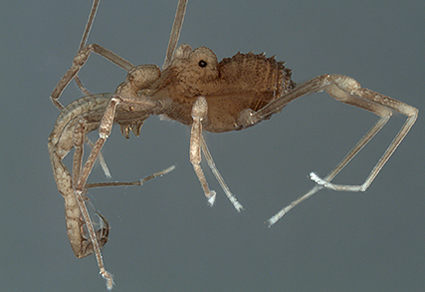Abstract
The holotype of Tetebius latibunus Roewer, 1949, and the topotype material of Malgaceros boviceps Lawrence, 1959, were thoroughly examined and compared. No morphological differences were found between these specimens. Consequently, a new synonymy is herein proposed, identifying Malgaceros boviceps as a synonym of Tetebius latibunus, and subsequently, Malgaceros Lawrence, 1959, as a synonym of Tetebius Roewer, 1949. Additionally, the holotype of Tetebius latibunus is considered a minor male, whereas the junior synonym Malgaceros boviceps is considered as a major male. A revised description and detailed illustration of the species Tetebius latibunus are provided, based on a comprehensive review of the holotype and numerous specimens that were collected in Nosy Be, Madagascar, the type locality of Malgaceros boviceps. The original type locality attributed to Tetebius latibunus by Roewer (Tete, Mozambique) is now believed to be a mislabeling, and the species is considered endemic to Madagascar.
References
- Acosta, L.E. (2002) Acrographinotus mitmaj, a new Harvestman species from Central Peru (Opiliones, Gonyleptidae, Pachylinae). Journal of Arachnology, 30, 78–83. https://doi.org/10.1636/0161-8202(2002)030[0078:AMANHS]2.0.CO;2
- Acosta, L.E., Pérez-González, A. & Tourinho, A.L. (2007) Methods for taxonomic study. In: Pinto-da-Rocha, R., Machado, G. & Giribet, G. (Eds.), Harvestmen: The Biology of Opiliones. Harvard University Press, Cambridge, pp. 494–510.
- Antonelli, A., Smith, R.J., Perrigo, A.L., Crottini, A., Hackel, J., Testo, W., Farooq, H., Torres Jiménez, M.F., Andela, N., Andermann, T., Andriamanohera, A.M., Andriambololonera, S., Bachman, S.P., Bacon, C.D., Baker, W.J., Belluardo, F., Birkinshaw, C., Borrell, J.S., Cable, S., Canales, N.A., Carrillo, J.D., Clegg, R., Clubbe, C., Cooke, R.S.C., Damasco, G., Dhanda, S., Edler, D., Faurby, S., De Lima Ferreira, P., Fisher, B.L., Forest, F., Gardiner, L.M., Goodman, S.M., Grace, O.M., Guedes, T.B., Henniges, M.C., Hill, R., Lehmann, C.E.R., Lowry, P.P., Marline, L., Matos-Maraví, P., Moat, J., Neves, B., Nogueira, M.G.C., Onstein, R.E., Papadopulos, A.S.T., Perez-Escobar, O.A., Phelps, L.N., Phillipson, P.B., Pironon, S., Przelomska, N.A.S., Rabarimanarivo, M., Rabehevitra, D., Raharimampionona, J., Rajaonah, M.T., Rajaonary, F., Rajaovelona, L.R., Rakotoarinivo, M., Rakotoarisoa, A.A., Rakotoarisoa, S.E., Rakotomalala, H.N., Rakotonasolo, F., Ralaiveloarisoa, B.A., Ramirez-Herranz, M., Randriamamonjy, J.E.N., Randriamboavonjy, T., Randrianasolo, V., Rasolohery, A., Ratsifandrihamanana, A.N., Ravololomanana, N., Razafiniary, V., Razanajatovo, H., Razanatsoa, E., Rivers, M., Sayol, F., Silvestro, D., Vorontsova, M.S., Walker, K., Walker, B.E., Wilkin, P., Williams, J., Ziegler, T., Zizka, A. & Ralimanana, H. (2022) Madagascar’s extraordinary biodiversity: Evolution, distribution, and use. Science, 378, eabf0869. https://doi.org/10.1126/science.abf0869
- Buzatto, B.A. & Machado, G. (2014) Male dimorphism and alternative reproductive tactics in harvestmen (Arachnida: Opiliones). Behavioural Processes, 109, 2–13. https://doi.org/10.1016/j.beproc.2014.06.008
- Giribet, G. & Kury, A.B. (2007) Phylogeny and Biogeography. In: Pinto-da-Rocha, R. Machado, G. & Giribet, G. (Eds.), Harvestmen: the Biology of Opiliones. Harvard University Press, Cambridge, pp. 62–87.
- Gnaspini, P. & Rodrigues, G.C.S. (2011) Comparative study of the morphology of the gland opening area among Grassatores harvestmen (Arachnida, Opiliones, Laniatores). Journal of Zoological Systematics and Evolutionary Research, 49, 273–284. https://doi.org/10.1111/j.1439-0469.2011.00626.x
- Gong, X., Martens, J. & Zhang, C. (2018) Two new species of Biantes from China and Malaysia (Opiliones: Laniatores: Biantidae). Zootaxa, 4461 (4), 587–599. https://doi.org/10.11646/zootaxa.4461.4.8
- Helversen, O. von & Martens, J. (1972) Unrichtige Fundort-Angaben in der Arachniden-Sammlung Roewer. Senckenbergiana biologica, 53 (1/2), 109–123.
- Kury, A.B. & Medrano, M. (2016) Review of terminology for the outline of dorsal scutum in Laniatores (Arachnida, Opiliones). Zootaxa, 4097 (1), 130–134. https://doi.org/10.11646/zootaxa.4097.1.9
- Kury, A.B., Mendes, A.C., Cardoso, L., Kury, M.S., Granado, A.A., Cruz-López, J.A., Longhorn, S.J., Medrano, M., Kury, I.S. & Souza-Kury, M.A. (2022) World Catalogue of Opiliones. WCO-Lite Version 2.5.0. Available from: https://wcolite.com/ (accessed 5 October 2023)
- Kury, A.B. & Pérez-González, A. (2007) Biantidae Thorell, 1889. In: Pinto-da-Rocha, R., Machado, G. & Giribet, G. (Eds.), Harvestmen: the Biology of Opiliones. Harvard University Press, Cambridge, pp. 176–179.
- Kury, A.B. & Pérez-González, A. (2015) A companion to Part 2 of the World Checklist of Opiliones species (Arachnida): Laniatores – Samooidea, Zalmoxoidea and Grassatores incertae sedis. Biodiversity Data Journal, 3, e6663. https://doi.org/10.3897/BDJ.3.e6663
- Lawrence, R.F. (1959) Arachnides-Opilions. Faune de Madagascar, Publications de L’Institut de Recherche Scientifique Tananarive – Tsimbazaza, 9, 1–121.
- Martens, J. (1978) Opiliones aus dem Nepal-Himalaya. IV. Biantidae (Arachnida). Senckenbergiana biologica, 58 (5/6), 347–414.
- Myers, N., Mittermeier, R.A., Mittermeier, C.G., Da Fonseca, G.A.B. & Kent, J. (2000) Biodiversity hotspots for conservation priorities. Nature, 403, 853–858. https://doi.org/10.1038/35002501
- Pérez-González, A. & Barroso, A.A. (2009) On the enigmatic Heterolacurbs ovalis Roewer, 1912 (Opiliones, Laniatores, Biantidae). Zootaxa, 2269 (1), 65–67. https://doi.org/10.11646/zootaxa.2269.1.5
- Pinto-da-Rocha, R. (2002) Systematic review and cladistic analysis of the Caelopyginae (Opiliones: Gonyleptidae). Arquivos de Zoologia, 36 (4), 357–464.
- Posit Team (2024) RStudio: Integrated Development Environment for R, Posit Software, PBC, Boston, MA. Available from: http://www.posit.co/ (accessed 29 August 2024)
- R Core Team (2023) R: A Language and Environment for Statistical Computing. R Foundation for Statistical Computing, Vienna. Available from: https://www.R-project.org/ (accessed 29 August 2024)
- Roewer, C.F. (1915) 106 neue Opilioniden. Archiv für Naturgeschichte, Berlin, Abteilung A, 81 (3), 1–152.
- Roewer, C.F. (1927) Weitere Weberknechte I. bhandlungen der Naturwissenschaftlichen Verein zu Bremen, 26 (2), 261–402.
- Roewer, C.F. (1949) Über Phalangodidae II. Weitere Weberknechte XIV. Senckenbergiana, 30 (4), 247–289.
- Schwendinger, P.J. & Martens, J. (2002) A taxonomic revision of the family Oncopodidae III. Further new species of Gnomulus Thorell (Opiliones, Laniatores). Revue suisse de zoologie, 109, 47–113. https://doi.org/10.5962/bhl.part.79580
- Shorthouse, D.P. (2010) SimpleMappr, an online tool to produce publication-quality point maps. Available from: http://simplemappr.net (accessed 6 October 2023)
- Staręga, W. (1992) An annotated check-list of Afrotropical harvestmen, excluding the Phalangiidae (Opiliones). Annals of the Natal Museum, 33 (2), 271–336.
- Vences, M., Wollenberg, K.C., Vieites, D.R. & Lees, D.C. (2009) Madagascar as a model region of species diversification. Trends in Ecology & Evolution, 24, 456–465. https://doi.org/10.1016/j.tree.2009.03.011
- Wickham, H. (2016) ggplot2: Elegant Graphics for Data Analysis. Springer-Verlag, New York, New York, XVI + 260 pp. https://doi.org/10.1007/978-3-319-24277-4
- Wolff, J.O., Schönhofer, A.L., Martens, J., Wijnhoven, H., Taylor, C.K. & Gorb, S.N. (2016) The evolution of pedipalps and glandular hairs as predatory devices in harvestmen (Arachnida, Opiliones). Zoological Journal of the Linnean Society, 177, 558–601. https://doi.org/10.1111/zoj.12375


